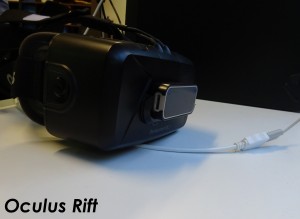
Virtual reality just got real
In a world striving to push the educational boundaries, virtual reality may be the technology that puts society one step closer to pushing through that boundary.
Education and Virtual Reality
As the world’s educational systems grow and expand, so does the challenge for new and innovative ways to teach students. Virtual reality puts users in a setting that feels real and lifelike but physically isn’t real. Whether users are experiencing a scenic walk on a hillside, slicing flying fruit or using virtual reality to understand anatomy, the possibilities are endless.

Virtual Reality in the Classroom
Students adapt to learning techniques in a variety of ways. Among the most popular techniques in the classroom is the use of visual aids and a hands-on approach to give students a reenactment of a real life situation.
Research shows that the majority of information learned and retained is done through visual and hands-on learning. Virtual reality can bring scenarios and lessons from real life situations into the classrooms and into student’s hands.
Steven Sutherland, assistant professor of psychology in the applied cognitive psychology program said students who use these virtual reality trainings and programs will be better prepared for job requirements.
“When you’re looking at training specialized skills, it’s really hard to say ‘do this specialized skill and go out into the job market where you’ve never had any physical experience’,” Sutherland said.
Although they may have never physically put their hands on anything but the virtual reality simulator, these students are still gaining experience and skills beyond those taught or learned from observations or lectures in the classroom.
Sutherland said that UHCL’s Perception and Action Lab is conducting and researching data related to virtual reality and how it impacts the user.
“There’s a lot you can do from an educational component that you can’t do in a physical environment,” Sutherland said. “Students taking online courses often times miss those hands-on or real experiences you would get in the classroom. If virtual reality is going to be used for an educational component, it needs to go beyond redesigning the traditional institution.”
Student Experience
With the addition of virtual reality, lesson plans could involve virtual tours and life-like demonstrations that will help students retain information.
“You don’t know how you’re going to respond to something until you actually have to face it,” Sutherland said. “So if you can try to simulate those types of environments and give people practice on how to respond to it, it at least speeds up that learning process when it actually does occur.”
Frank Delgado, project manager for the Hybrid Reality lab and engineer at NASA, discussed how virtual reality could change the way users are taught and learn.
“You can digitize a lot of the learning content and go from reading a book about a museum or dissecting a frog to actually experiencing it,” Delgado said.
Virtual reality would allow students who take online courses the possibility of having a hands-on experience without physically being in class. Students could experience an online lecture or lesson and feel as though they are sitting front and center.
“It allows you to create something that people would never be able to interact with,” Sutherland said. “The more immersion that you get, the more you can do creating educational components.”
Immersion Drawbacks
Sutherland said one of the issues virtual reality platforms are face is simulation sickness. The occasional system lag or glitch can severely impact how one’s body reacts when using a virtual reality headset. He explained that students are researching how to reduce simulation sickness through different levels of immersion in virtual reality.
For example, the university will be getting some Omni virtual reality platforms to help research the study of simulation sickness. The research will analyze and perhaps offset the causes and effects of simulation sickness caused by virtual reality systems.
Delgado explained that simulation sickness can be reduced when the virtual platform is tuned properly and adapted to training situations. He explained that his team primarily uses the HTC Vive, which allows users to move around more freely.
“We reduced the amount of lag time and have the performance turned up enough where we’re getting 90 frames per second,” Delgado said. “Typically if you have 90 frames per second, you significantly reduce the chance that you’re going to feel sick.”
Delgado and his team are focusing on how realistic they can make a simulation to better prepare astronauts and engineers for missions. Virtual reality is being used to help train astronauts for future missions and simulations in space.
“We’re using virtual reality at NASA to train astronauts,” Delgado said. “How realistic can we turn the training environment into so that when an astronaut or engineer is doing analysis for training, they feel like they are working with a real physical item.”
Learn more about virtual reality outside of the classroom!

Shared this on LinkedIn! Love it!